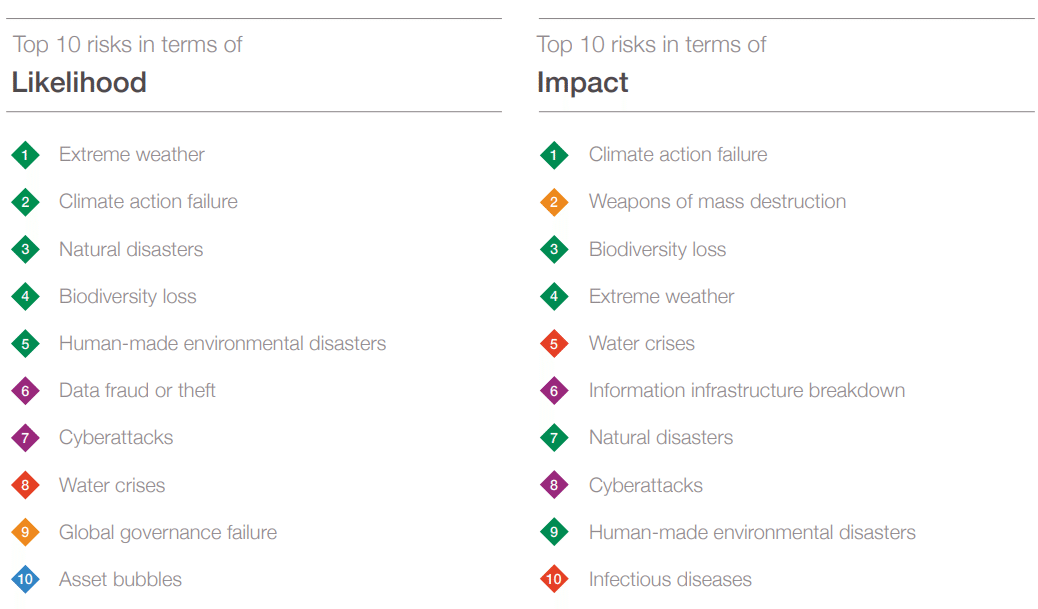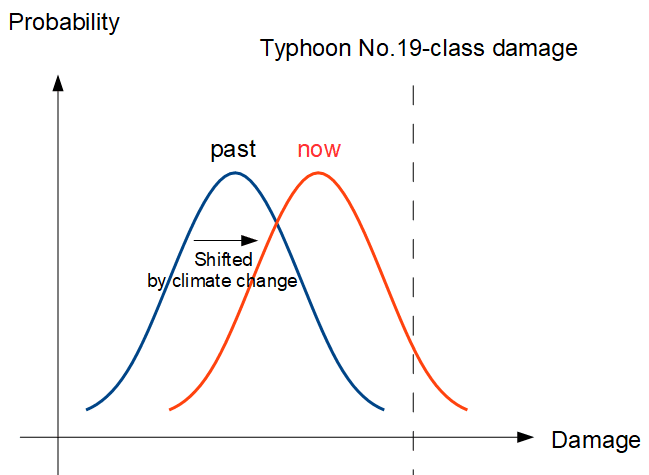
No.6|What we currently know about the climate crisis
This article is a translation of this article.
Correct knowledge of the global environment, now and in the future, is important for planning countermeasures. If you think that the summer in Japan will get a little hotter in the future, you will be in a lot of pain.
The World Economic Forum's Global Risks Report (2020) opens with a list of future risks that world leaders are considering.


Cited from http://www3.weforum.org/docs/WEF_Global_Risk_Report_2020.pdf
The table above shows the aggregate results of the survey respondents on a 5-point scale. For likelihood, 1 represents a low probability risk, 5 represents a very high probability risk, and for impact, 1 represents almost no impact and 5 represents a catastrophic impact. According to the results, "climate change" and "loss of biodiversity" were the most frequently cited issues, indicating that world leaders have a strong sense of urgency about these issues.
Alarmingly, global temperatures are on track to increase by at least 3°C towards the end of the century—twice what climate experts have warned is the limit to avoid the most severe economic, social and environmental consequences. The nearterm impacts of climate change add up to a planetary emergency that will include loss of life, social and geopolitical tensions and negative economic impacts
The current rate of extinction is tens to hundreds of times higher than the average over the past 10 million years—and it is accelerating. Although the world’s 7.6 billion people represent just 0.01% of all living creatures, humanity has already caused the loss of 83% of all wild mammals and half of plants. If low estimates of the number of species are accurate—around 2 million—between 200 and 2,000 extinctions are occurring every year. At the upper end of the estimate, between 10,000 and 100,000 species are going extinct each year.
Cited from http://www3.weforum.org/docs/WEF_Global_Risk_Report_2020.pdf
The extinction rate is so fast that it is now called the "sixth extinction period". Of course, once an organism goes extinct, it never comes back. Even if you lose it and then realize its importance, you cannot redeem it.

Cited from
https://www.millenniumassessment.org/documents/document.356.aspx.pdf
In the next section, we will present more detailed data.
①How much has the temperature risen to date?
According to the AR5 SYNTHESIS REPORT, it has risen by about 0.85 degrees in 100 years.

Cited from AR5 SYNTHESIS REPORT
And future temperatures are expected to be as follows

Cited from AR5 SYNTHESIS REPORT
If we work hard in the future to reduce greenhouse gas emissions, the temperature increase can be contained along the blue line (RCP2.6 scenario) (2℃ by 2100). On the other hand, if we continue with our current lifestyle, the temperature will continue to rise along the red line (RCP8.5 scenario) (around 4℃ by 2100). Each line has a width because it contains an error in estimation.
Even achieving the RCP2.6 scenario, which would be hotter than the current one, is actually quite difficult. To achieve this goal, we need to reduce greenhouse gas emissions by 7.6% per year between 2020-30 compared to the previous year, according to the United Nations Environment Programme (UNEP). This is not possible without a fundamental change in our society's dependence on fossil fuels.
The graphs so far show the global average ground temperature. It is important to note that the world does not experience a uniform increase in temperature. There is considerable variability in temperature increases by region.
In general, terrestrial areas are more susceptible to global warming than the oceans, and areas at higher latitudes are more susceptible to global warming.
The figure below shows the temperature change at the end of the 21st century for the two scenarios discussed earlier (RCP2.6 and RCP8.5), where the average increase in temperature in the RCP8.5 scenario is about 4℃, while the Arctic is expected to increase by nearly 12℃. It is important to note that averages are only averages and not actual values.

Cited from AR5 SYNTHESIS REPORT
A more intuitive indication of the degree of heat may be the summer weather forecast in the RCP8.5 scenario for the year 2100 presented by the Ministry of the Environment. At these temperatures, simply going outside anywhere in the country can be life-threatening.

Expected weather forecast for the year 2100
Cited from https://ondankataisaku.env.go.jp/coolchoice/2100weather/
②What happens when the temperature rises?
The adverse effects of higher temperatures are expected to be the following events.
・Increase in heat stroke patients
・Reduced food production
・Increase in heavy rains and droughts
・Impact on the ecosystem
・etc.
As mentioned earlier, rising summer temperatures increase the number of heat stroke patients and make it difficult to work or walk around during the day. This heat wave will also have a significant impact on livestock and crops raised and grown outdoors. In addition, higher temperatures in the nearshore seas results in heavy rainfall and severe typhoon-related storm, flood, and storm surge damage. Changes in air currents, in some cases, can also cause droughts and unseasonable weather.
In fact, looking back on year 2019, Japan was riddled with extreme weather conditions. First, Typhoon No. 19 in October recorded the highest rainfall in recorded history in many areas, mainly in the Kanto region, and resulted in large-scale river flooding. (The part that stands like a needle is the spot that broke the record for the first place in the history of observation, and it looks like a needle mountain!) The average annual rainfall in Japan is about 1,700 mm, which shows how heavy the rainfall was. (In Hakone, half of the annual rainfall falls in 24 hours!)

Distribution of the period maximum of 24-hour precipitation
The winter of 2020 was also the warmest winter on record since the statistics began. The regional mean temperature anomalies are plotted. The average temperature is nearly two degrees above normal.

Comparison with average temperatures
(5-day moving average)
This change of several degrees Celsius is likely to cause disasters that have never occurred before. The figure below shows the damage and probability of occurrence of a disaster in the past and present schematically. As a result of the rightward shift of the probability distribution due to the rise in temperature, catastrophes such as Typhoon No. 19 started to occur with significant probability. That is, the "once-in-a-century" disaster has changed to, say, a "once-in-decade" event, a sign that the anomaly is beginning to become less of an anomaly.

Probability distribution of disasters caused by climate change
Take river flooding, for example. Heavy rains do not cause great damage as long as the river water does not overtake the banks. But if a little extra water to a river is added that is about to overflow, it immediately starts to overflow, crosses the banks, and begins to cause damage to the city. A small change can often mean the difference between the fate of the damage.
The Australian forest fires of 2019 are another example. More than 100,000 square kilometers of forest have been lost in a series of fires. This is nearly 1/3 of the area of Japan.
Prof Richard Betts from the Met Office Hadley Centre said we are "seeing a sign of what would be normal conditions under a future warming world of 3C".
"Temperatures in December in Australia, that have occurred recently, they are extreme for now but they would be normal under a world getting on for three degrees of warming, so we are seeing a sign of what would be normal conditions under a future warming world of 3 degrees," Prof Betts explained.
Cited from https://www.bbc.com/news/science-environment-51094919
We also know that a few degrees of temperature increase can be fatal to coral reefs. Corals are vulnerable to heat, with the IPCC reporting a 70-90% reduction with a 1.5 degree Celsius increase and more than 99% disappearance with a 2 degree Celsius increase. Coral reefs are called keystone species, and their loss is extremely damaging to the ecosystem.
In addition, global warming also causes sea level rise. At the end of the 21st century, the RCP8.5 scenario assumes a 45-82 cm rise in the volume of seawater, due to the melting of ice on land and the expansion of the volume of seawater due to rising temperatures. As the sea level rises, some countries begin to sink. And the impact on Japan will be impossible to ignore. The expansion of the zero-elevation zone (land whose elevation is lower than the sea level at high tide) may lead to a synergistic increase in the damage caused by violent typhoons developed by global warming, which will create more storm surges on a larger scale.
Don't underestimate the importance of a few degrees. It could be the beginning of a tremendous disaster. There may be a non-zero probability that it won't happen, but once you've moved on, there's no turning back.
